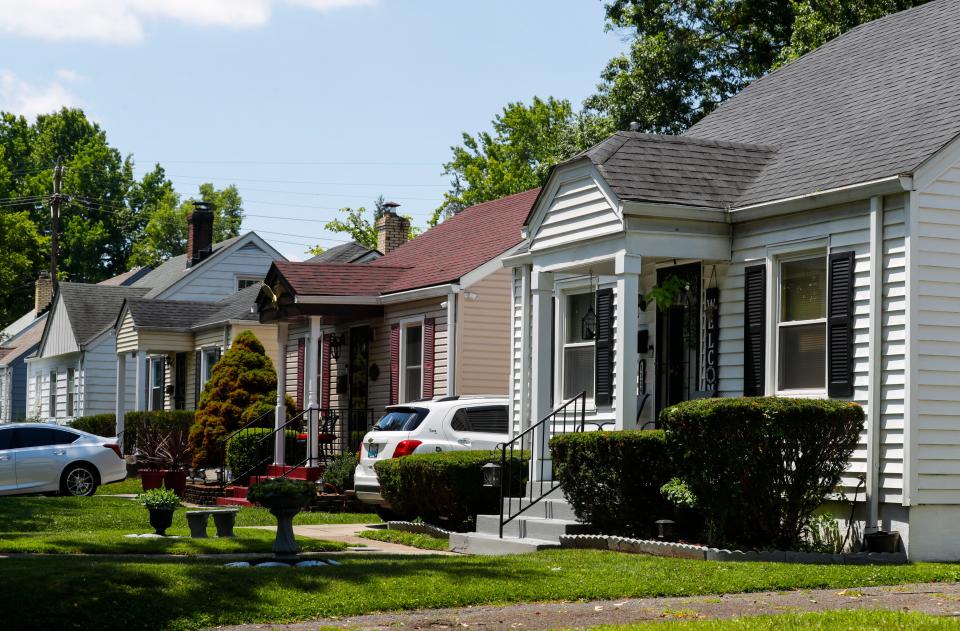Segregation was intentional – and it didn't end when Jim Crow did. Come learn why.
- Oops!Something went wrong.Please try again later.
In the late 1940s Black community members were relegated to substandard housing in certain parts of Louisville. Cheri Bryant Hamilton, longtime Chickasaw resident, former city council member and co-chair of the Chickasaw Book Project Committee, knows her family story well. Her father, Roscoe Bryant, was a physician, moving from Tulsa, Oklahoma, to Louisville. He struggled to find adequate housing and could only secure a small four-room rental house owned by a fellow Red Cross Hospital physician. The Bryants had one child and another one on the way. Bryant's wife Ruth asked if they could please find another place to stay but he told her there was “nowhere to move.”
Hamilton's family story is common, not only for Louisville but across the country thanks to this nation's history of segregation.
Segregation is often thought of (especially by white people) as a thing of the past. Something that the civil rights movement of the 1960s worked to undo. We think of lunch counter sit-ins, Martin Luther King Jr. and the March on Washington. These are the historic moments we were taught in school. The part of history that many lessons left out was the discrimination in housing. The way real estate was sold, mortgage loans were obtained and titles were insured because of policies like redlining and the practice of restrictive covenants.
Buying houses in Louisville designated for whites only
Joseph R. Ray, a Black real estate agent, is quoted in a 1950 Courier Journal article saying, “Our people have been cramped for space."
Read these books. Want to understand what it means to be anti-racist?
Deeds on white-owned property included restrictive covenants that stated the house could not be rented, sold or otherwise transferred to a person of color. Even if a white person agreed to sell a house to a Black buyer, loan companies would not lend money without title insurance, and title companies would not insure a title when the sale to a Black person violated a deed restriction.
Meanwhile the post-World War II GI Bill guaranteeing low-interest mortgages and other loans with low or zero down payments to veterans secured financial footing for America's white middle class. By 1952, 2.4 million veterans had received government-backed loans. But the 1.2 million Black military men who served were excluded. White Americans got a jump start building generational wealth while Black Americans faced hurdle after hurdle after hurdle.

Louisville's racist housing restrictions fought in court
In 1939 Black-owned Standard Realty Corp. signed a written contract with the Westover Development Co. for 19 undeveloped acres near Chickasaw park. Alarmed white neighbors to the north formed a company to purchase the land instead. But when the seller attempted to renege, Standard Realty sued and won. Then, the Court of Appeals upheld the lower court’s decision in 1943. The landmark case called McCurdy v. Standard Realty Corp established a new subdivision free of racial deed restrictions and became what we now know as the Chickasaw neighborhood.
In 1950, the Shawnee Foundation also formed. Around 100 neighbors chipped in to buy the house at 1028 Western Parkway to ensure their block would stay a white one.
Meanwhile, other white families simply wanted out. Deed restrictions worked against them, too. A suit was filed in March of 1950 by property owners on the 3200 Block of Virginia Avenue asking the court to kill deed restrictions so they can sell their property to Black buyers. According to a 1950 Courier Journal article by Grady Clay, “A large proportion of the property in Louisville has deed restrictions against Negro ownership, this cuts down loans to Black residents considerably.”
What does this past segregation mean for Louisville now?
Though Jim Crow laws are no longer on the books or tolerated, our government has not purposefully sought to rectify the inequities that racist housing laws established. Segregation was intentional and its effects cannot be undone without the same intentionality.
In his book, "The Color of Law," Richard Rothstein showed how segregation could not have been sustained without policies at every level of government to back it up. It is why a dangerous Black-white wealth gap exists. His new book “Just Action” co-written with his daughter, Leah Rothstein, aims to answer the question, “So, what do we do about it?”
Kids are in crisis: Services are collapsing. What's a Family Court judge supposed to do?
We cannot simply say every neighborhood is open to every race now and think that's enough. Louisville must address housing inequities and the wealth gap that was created due to segregation.
The Rothsteins' book stresses that anti-displacement strategies are key. Louisville Metro Council is currently considering an anti-displacement ordinance to protect West End residents and encourage community-led development with the goal of revitalization and not gentrification. The ordinance is a good start.
In the 2022 state of housing report, The Louisville Metro Housing Coalition recommended several ways our city could support "Just Housing."
Rent control is one way to help prevent displacement. However, rent control is illegal in Kentucky and requires legislative action for Louisville to implement.
Another way is with inclusionary zoning, which would require builders to include affordable units in developments of a specific size. This ensures that new residential developments, whether these are apartments for rent or condos/townhomes for sale, would include some affordable homes in their plans.
Continue the conversation on equitable and affordable housing at these two events
The Courier Journal has partnered with the Louisville Free Public Library to welcome housing policy expert and author Leah Rothstein for a discussion of her new book, "Just Action: How to Challenge Segregation Enacted Under the Color of Law," co-written with her father Richard Rothstein. The book is a follow-up to her father’s bestseller, "The Color of Law," which examined institutionally created segregation in America. Just Action lays out ways our society can undo this institutional segregation – including housing reform. Also joining the conversation is Marilyn Harris, director for the Office of Housing and Community Development. The event takes place at LFPL's Main Branch on Oct. 25 at noon. No registration necessary.
On Oct. 29 at The Yearlings Club on 4309 W. Broadway, The Chickasaw Book Project Committee will celebrate the 80th Anniversary of the historic 1943 Kentucky Court of Appeals decision that created the first Black subdivision in Louisville’s West End.
It’s time for Louisville residents to better understand how our neighborhoods came to be and the intentional work that needs to happen to rectify policy-driven segregation.

Bonnie Jean Feldkamp is the opinion editor. She can be reached via email at BFeldkamp@Gannett.com or on social media @WriterBonnie.
This article originally appeared on Louisville Courier Journal: Segregation caused today's wealth gap. Housing policy must rectify it

